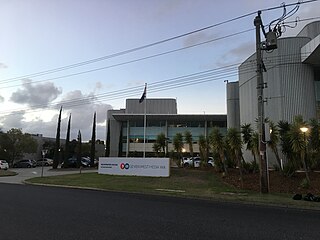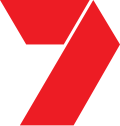
Closed captioning (CC) is a form of subtitling, a process of displaying text on a television, video screen, or other visual display to provide additional or interpretive information, where the viewer is given the choice of whether the text is displayed. Closed captions are typically used as a transcription of the audio portion of a program as it occurs, sometimes including descriptions of non-speech elements. Other uses have included providing a textual alternative language translation of a presentation's primary audio language that is usually burned-in to the video and unselectable.

ITV, legally known as Channel 3, is a British free-to-air public broadcast television network. It is branded as ITV1 in most of the UK except for central and northern Scotland, where it is branded as STV. It was launched in 1955 as Independent Television to provide competition, eliminating what had been the monopoly of BBC Television. ITV is the oldest commercial network in the UK. Since the passing of the Broadcasting Act 1990, it has been legally known as Channel 3 to distinguish it from the other analogue channels at the time: BBC1, BBC2 and Channel 4.

Ceefax was the world's first teletext information service and a forerunner to the current BBC Red Button service. Ceefax was started by the BBC in 1974 and ended, after 38 years of broadcasting, at 23:32:19 BST on 23 October 2012, in line with the digital switchover completion in Northern Ireland.

Television New Zealand, more commonly referred to as TVNZ, is a television network that is broadcast throughout New Zealand and parts of the Pacific region. All of its currently-operating channels are free-to-air and commercially funded.

The Seven Network is a major Australian commercial free-to-air television network. It is owned by Seven West Media Limited, and is one of the five main free-to-air television networks in Australia. The network's headquarters are located in Sydney.

TEN is Network 10's flagship station in Sydney. It was originally owned and operated by United Telecasters Sydney Limited (UTSL), and began transmission on 5 April 1965 with the highlight of the opening night being the variety special TV Spells Magic. It also serves as the Australian headquarters of Paramount.

Television in Australia began experimentally as early as 1929 in Melbourne with radio stations 3DB and 3UZ, and 2UE in Sydney, using the Radiovision system by Gilbert Miles and Donald McDonald, and later from other locations, such as Brisbane in 1934.

ATN is the Sydney flagship television station of the Seven Network in Australia. The licence, issued to a company named Amalgamated Television Services, a subsidiary of John Fairfax & Sons, was one of the first four licences to be issued for commercial television stations in Australia. The station formed an affiliation with GTV-9 Melbourne in 1957, in order to share content. In 1963, Frank Packer ended up owning both GTV-9 and TCN-9, so as a result the stations switched their previous affiliations. ATN-7 and HSV-7 joined to create the Australian Television Network, which later became the Seven Network. ATN-7 is the home of the national level Seven News bulletins.
Datacasting is the transmission of data over a wide area using radio waves. It typically refers to supplemental information sent by television stations alongside digital terrestrial television (DTT) signals. However, datacasting can also be applied to digital data signals carried on analog TV or radio broadcasts.

Teletext, or broadcast teletext, is a standard for displaying text and rudimentary graphics on suitably equipped television sets. Teletext sends data in the broadcast signal, hidden in the invisible vertical blanking interval area at the top and bottom of the screen. The teletext decoder in the television buffers this information as a series of "pages", each given a number. The user can display chosen pages using their remote control. In broad terms, it can be considered as Videotex, a system for the delivery of information to a user in a computer-like format, typically displayed on a television or a dumb terminal, but that designation is usually reserved for systems that provide bi-directional communication, such as Prestel or Minitel.

BTQ is the Brisbane television station of the Seven Network in Australia. BTQ was the second television station to launch in Brisbane, going to air on 1 November 1959, after QTQ launched three months earlier and before ABQ launched just 1 day after BTQ's launch.

ExtraVision was a teletext service created and operated by the American television network CBS in the early to mid-1980s. It was carried in the vertical blanking interval of the video from local affiliate stations of the CBS network. It featured CBS program information, news, sports, weather, even subtitling for CBS programming. ExtraVision could also have its pages customized by the local affiliate station carrying it, for such things as program schedules, local community announcements, and station promotions. WGBH Boston, a pioneer in assisting the deaf and hard-of-hearing with closed captioning, also provided content for those audiences to ExtraVision and assisted in providing captioning for CBS programming via ExtraVision.

HSV is a television station in Melbourne, Australia. It is part of the Seven Network, one of the three main commercial television networks in Australia, its first and oldest station. It launched in time for the 1956 Summer Olympic Games in Melbourne. HSV-7 is the home of AFL coverage.
ABC Television is the general name for the national television services of the Australian Broadcasting Corporation (ABC). Until an organisational restructure in 2017/2018, ABC Television was also the name of a division of the ABC. The name was also used to refer to the first and for many years the only national ABC channel, before it was renamed ABC1 and then again to ABC TV.
Swindon Cable was the UK's first commercial cable TV franchise. It was originally set up by Thorn Ltd as Radio Rentals Cable Television; the local company name was later changed to Swindon Cable. As well as relaying satellite channels, it operated its own local cable TV channel known as Swindon's Local Channel. It closed permanently in 2000, after 16 years of broadcasting mostly local programming on the Wiltshire town's cable TV system.

The Nine Guide was a television datacast channel provided by the Nine Network to digital television viewers in Australia. It began broadcasting on 21 August 2001, in Sydney broadcasting 24 hours a day. The channel expanded to fellow Nine Network stations in Melbourne and Brisbane in 2002. The Guide was modified for state-based programming and program promotions.
TVNZ teletext was the only analogue teletext in New Zealand. It was also available on Freeview and was launched on 1 February 1984 with funding raised in the 1981 New Zealand Telethon, to provide news and information for the deaf. The service was improved in 2006, incorporating more information.

Seven West Media Limited is an Australian ASX-listed media company and it is Australia's largest diversified media business, with an extensive presence in broadcast television, radio, print and online publishing. It is Home to the Seven Network Station, TVW.
NBC Teletext was a teletext service provided by the American TV network NBC from 1981 to 1985, based on the NABTS standard.












